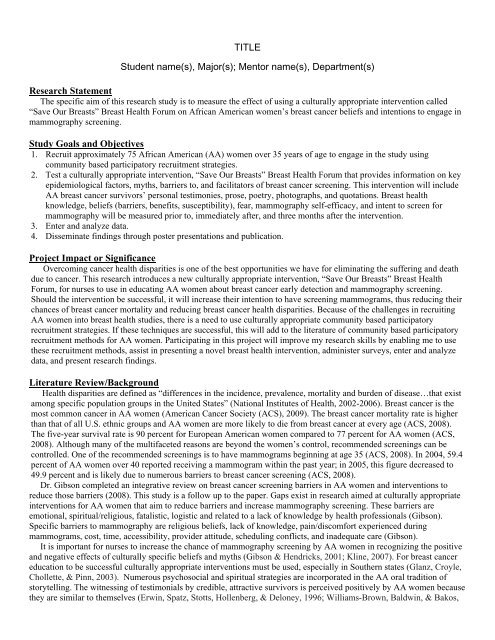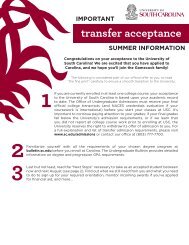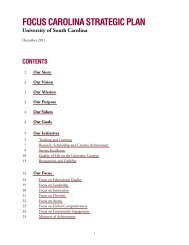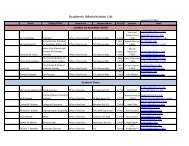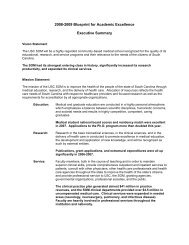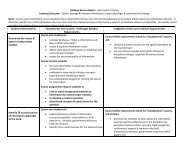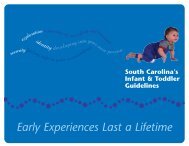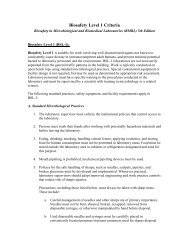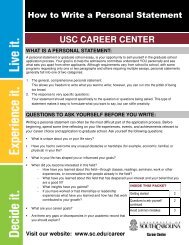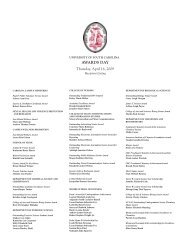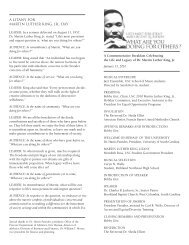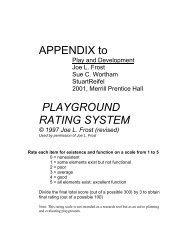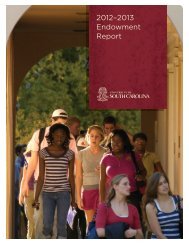Research Statement Study Goals and Objectives Project Impact or ...
Research Statement Study Goals and Objectives Project Impact or ...
Research Statement Study Goals and Objectives Project Impact or ...
You also want an ePaper? Increase the reach of your titles
YUMPU automatically turns print PDFs into web optimized ePapers that Google loves.
<strong>Research</strong> <strong>Statement</strong><br />
The specific aim of this research study is to measure the effect of using a culturally appropriate intervention called<br />
“Save Our Breasts” Breast Health F<strong>or</strong>um on African American women’s breast cancer beliefs <strong>and</strong> intentions to engage in<br />
mammography screening.<br />
<strong>Study</strong> <strong>Goals</strong> <strong>and</strong> <strong>Objectives</strong><br />
1. Recruit approximately 75 African American (AA) women over 35 years of age to engage in the study using<br />
community based participat<strong>or</strong>y recruitment strategies.<br />
2. Test a culturally appropriate intervention, “Save Our Breasts” Breast Health F<strong>or</strong>um that provides inf<strong>or</strong>mation on key<br />
epidemiological fact<strong>or</strong>s, myths, barriers to, <strong>and</strong> facilitat<strong>or</strong>s of breast cancer screening. This intervention will include<br />
AA breast cancer surviv<strong>or</strong>s’ personal testimonies, prose, poetry, photographs, <strong>and</strong> quotations. Breast health<br />
knowledge, beliefs (barriers, benefits, susceptibility), fear, mammography self-efficacy, <strong>and</strong> intent to screen f<strong>or</strong><br />
mammography will be measured pri<strong>or</strong> to, immediately after, <strong>and</strong> three months after the intervention.<br />
3. Enter <strong>and</strong> analyze data.<br />
4. Disseminate findings through poster presentations <strong>and</strong> publication.<br />
<strong>Project</strong> <strong>Impact</strong> <strong>or</strong> Significance<br />
Overcoming cancer health disparities is one of the best opp<strong>or</strong>tunities we have f<strong>or</strong> eliminating the suffering <strong>and</strong> death<br />
due to cancer. This research introduces a new culturally appropriate intervention, “Save Our Breasts” Breast Health<br />
F<strong>or</strong>um, f<strong>or</strong> nurses to use in educating AA women about breast cancer early detection <strong>and</strong> mammography screening.<br />
Should the intervention be successful, it will increase their intention to have screening mammograms, thus reducing their<br />
chances of breast cancer m<strong>or</strong>tality <strong>and</strong> reducing breast cancer health disparities. Because of the challenges in recruiting<br />
AA women into breast health studies, there is a need to use culturally appropriate community based participat<strong>or</strong>y<br />
recruitment strategies. If these techniques are successful, this will add to the literature of community based participat<strong>or</strong>y<br />
recruitment methods f<strong>or</strong> AA women. Participating in this project will improve my research skills by enabling me to use<br />
these recruitment methods, assist in presenting a novel breast health intervention, administer surveys, enter <strong>and</strong> analyze<br />
data, <strong>and</strong> present research findings.<br />
Literature Review/Background<br />
Health disparities are defined as “differences in the incidence, prevalence, m<strong>or</strong>tality <strong>and</strong> burden of disease…that exist<br />
among specific population groups in the United States” (National Institutes of Health, 2002-2006). Breast cancer is the<br />
most common cancer in AA women (American Cancer Society (ACS), 2009). The breast cancer m<strong>or</strong>tality rate is higher<br />
than that of all U.S. ethnic groups <strong>and</strong> AA women are m<strong>or</strong>e likely to die from breast cancer at every age (ACS, 2008).<br />
The five-year survival rate is 90 percent f<strong>or</strong> European American women compared to 77 percent f<strong>or</strong> AA women (ACS,<br />
2008). Although many of the multifaceted reasons are beyond the women’s control, recommended screenings can be<br />
controlled. One of the recommended screenings is to have mammograms beginning at age 35 (ACS, 2008). In 2004, 59.4<br />
percent of AA women over 40 rep<strong>or</strong>ted receiving a mammogram within the past year; in 2005, this figure decreased to<br />
49.9 percent <strong>and</strong> is likely due to numerous barriers to breast cancer screening (ACS, 2008).<br />
Dr. Gibson completed an integrative review on breast cancer screening barriers in AA women <strong>and</strong> interventions to<br />
reduce those barriers (2008). This study is a follow up to the paper. Gaps exist in research aimed at culturally appropriate<br />
interventions f<strong>or</strong> AA women that aim to reduce barriers <strong>and</strong> increase mammography screening. These barriers are<br />
emotional, spiritual/religious, fatalistic, logistic <strong>and</strong> related to a lack of knowledge by health professionals (Gibson).<br />
Specific barriers to mammography are religious beliefs, lack of knowledge, pain/discomf<strong>or</strong>t experienced during<br />
mammograms, cost, time, accessibility, provider attitude, scheduling conflicts, <strong>and</strong> inadequate care (Gibson).<br />
It is imp<strong>or</strong>tant f<strong>or</strong> nurses to increase the chance of mammography screening by AA women in recognizing the positive<br />
<strong>and</strong> negative effects of culturally specific beliefs <strong>and</strong> myths (Gibson & Hendricks, 2001; Kline, 2007). F<strong>or</strong> breast cancer<br />
education to be successful culturally appropriate interventions must be used, especially in Southern states (Glanz, Croyle,<br />
Chollette, & Pinn, 2003). Numerous psychosocial <strong>and</strong> spiritual strategies are inc<strong>or</strong>p<strong>or</strong>ated in the AA <strong>or</strong>al tradition of<br />
st<strong>or</strong>ytelling. The witnessing of testimonials by credible, attractive surviv<strong>or</strong>s is perceived positively by AA women because<br />
they are similar to themselves (Erwin, Spatz, Stotts, Hollenberg, & Deloney, 1996; Williams-Brown, Baldwin, & Bakos,
2002). Poetry <strong>and</strong> other narrative genres are received well also (Kline, 2007). Multifaceted culturally specific<br />
interventions by health care providers have resulted in significant differences in breast cancer knowledge, beliefs, <strong>and</strong><br />
behavi<strong>or</strong>s (Hall, 2005; Kline, 2007). These interventions included teaching that stressed m<strong>or</strong>bidity, m<strong>or</strong>tality, <strong>and</strong> survival<br />
statistics, susceptibility to breast cancer, breast cancer signs <strong>and</strong> symptoms, efficacy of treatments, women’s perceptions<br />
of the seriousness of the disease, barriers to <strong>and</strong> benefits of screening (Hall, 2005; Kline, 2007).<br />
Barriers to recruiting AA women into research studies also exist. Examples include fear, distrust <strong>and</strong> lack of<br />
knowledge (Office of <strong>Research</strong> on Women’s Health (ORWH), 2002). In <strong>or</strong>der f<strong>or</strong> successful recruitment it is critical f<strong>or</strong><br />
researchers to underst<strong>and</strong> the study population <strong>and</strong> be flexible <strong>and</strong> open to modifying <strong>or</strong> adding elements that deliberately<br />
consider the population (ORWH). Additionally, the involvement of AA spiritual institutions is essential to successful<br />
recruitment eff<strong>or</strong>ts with AA communities (Meinert, Blehar, Peindl, Neal-Barnett, & Wisner, 2003).<br />
Methodology <strong>and</strong> Student Responsibilities<br />
My involvement in the study will continue the research begun by Dr. Gibson in the spring of 2009 when she<br />
administered surveys to 35 AA women over 35. A quasi-experimental pre <strong>and</strong> post-test longitudinal design will be used.<br />
Using convenience sampling AA women over 35 from churches <strong>and</strong> community <strong>or</strong>ganizations will be invited to complete<br />
surveys that measure knowledge, beliefs, fear, mammography self-efficacy, <strong>and</strong> mammography screening intention pri<strong>or</strong><br />
to, immediately after, <strong>and</strong> three months after the “Save Our Breasts” Breast Health F<strong>or</strong>um. The f<strong>or</strong>um will provide<br />
epidemiological inf<strong>or</strong>mation, breast cancer signs <strong>and</strong> symptoms, AA breast cancer surviv<strong>or</strong>s’ personal testimonies, prose,<br />
poetry, photographs, <strong>and</strong> quotations. Initially my time will be spent recruiting study participants by meeting with<br />
respected AA church <strong>and</strong> community leaders to solicit their suggestions <strong>and</strong> supp<strong>or</strong>t. I will then plan meetings with AA<br />
women to present the study purpose <strong>and</strong> impact by using methods as recommended by the leaders. Previous examples<br />
used by Dr. Gibson <strong>and</strong> community leaders included distributing fliers <strong>and</strong> sending personal letters of invitation. During<br />
the f<strong>or</strong>um I will assist by facilitating discussions on barriers to breast cancer screening, myths about breast cancer, <strong>and</strong><br />
presenting st<strong>or</strong>ies of breast cancer surviv<strong>or</strong>s. I will administer the surveys bef<strong>or</strong>e, immediately after, <strong>and</strong> three months<br />
after the f<strong>or</strong>um, <strong>and</strong> enter <strong>and</strong> analyze the data using the Statistical Package of the Social Sciences (SPSS, 17 th edition). I<br />
will present a poster of preliminary findings at The Undergraduate <strong>Research</strong> Symposium at USC Upstate in March 2010, a<br />
poster at Discovery Day 2010, <strong>and</strong> write a manuscript f<strong>or</strong> publication into a refereed nursing journal.<br />
Timeline<br />
January-February<br />
Early March<br />
March - April<br />
April - May<br />
Early June<br />
June – early July<br />
Training on the Responsible Conduct of <strong>Research</strong> <strong>and</strong> review of articles<br />
Recruitment: meet with community leaders; advertise to recommended AA locations<br />
Submit abstract f<strong>or</strong> poster at The Undergraduate <strong>Research</strong> Symposium at USC Upstate<br />
Assist with the “Save Our Breasts” Breast Health F<strong>or</strong>um <strong>and</strong> administer surveys<br />
Enter <strong>and</strong> analyze pre/immediately post intervention data <strong>and</strong> prepare poster presentation<br />
Send reminders, contact women f<strong>or</strong> 3-month post-intervention surveys<br />
Administer 3-month post-intervention surveys<br />
Enter <strong>and</strong> analyze three-month post-intervention data<br />
Complete manuscript f<strong>or</strong> publication in a refereed nursing journal<br />
Anticipated Results<br />
I anticipate that after the “Save Our Breasts” Breast Health F<strong>or</strong>um, the AA women responding in the post-test surveys will<br />
have greater breast health knowledge, change in beliefs (greater benefits, fewer barriers, less susceptibility, less fear),<br />
increased mammography self-efficacy, <strong>and</strong> greater intention to engage in mammography screening. My project outcomes<br />
will include presenting at The Undergraduate <strong>Research</strong> Symposium at USC Upstate <strong>and</strong> Discovery Day 2010.<br />
Furtherm<strong>or</strong>e I will prepare a manuscript publication in a refereed journal.<br />
Personal <strong>Statement</strong><br />
I feel especially connected to the subject of breast cancer research because I have personally known members of my<br />
church family who are AA breast cancer surviv<strong>or</strong>s. Through these encounters I have seen the devastation of this disease,<br />
ranging from the effects of chemotherapy to the effects of having to have a mastectomy. As a nursing student I have had<br />
AA breast cancer patients whose prospect of surviving was not as hopeful because the cancer was found at a late stage.<br />
These women did not have recommended screening mammograms. I know numerous AA women who are reluctant to<br />
receive any type of medical care, including breast cancer screening <strong>and</strong> treatment, because of the stigmas held in the AA<br />
community. I am a seni<strong>or</strong> nursing student with a grade point average of a 3.9 <strong>and</strong> I have plans to pursue a master’s degree<br />
to be a women’s health nurse practitioner. One of my career goals is to help break the cycle of health disparities <strong>and</strong> I<br />
believe this research is a first step. I feel passionate about this research. I want to use this opp<strong>or</strong>tunity both as a nurse <strong>and</strong><br />
a future nurse practitioner, as a way to educate <strong>and</strong> break down some of the barriers to medical treatment, specifically on<br />
the subject of breast cancer screening by AA women.
References<br />
American Cancer Society (2009). Cancer Facts & Figures f<strong>or</strong> African Americans 2009-2010. Atlanta, GA: Auth<strong>or</strong>.<br />
American Cancer Society (2008). Breast Cancer Facts & Figures 2007-2008. Atlanta, GA: Auth<strong>or</strong>.<br />
Erwin, D. O., Spatz, T. S., Stotts, R. C., Hollenberg, J. A. & Deloney, L. (1996). Increasing mammography <strong>and</strong> breast<br />
self-examination in African American women using the Witness <strong>Project</strong> model. Journal of Cancer Education,<br />
11(4), 210-215.<br />
Gibson, L. (2008). Teaching Strategies to Facilitate Breast Cancer Screening by African American Women. Journal of<br />
National Black Nurses Association, 19(2), 41-48.<br />
Gibson, L., & Hendricks, C. S. (2001).Breast health <strong>and</strong> culture: Issues f<strong>or</strong> nursing practice. South Carolina Nurse,<br />
October-December, 18-19.<br />
Glanz, K., Croyle, R. T., Chollette, V. Y., & Pinn, V. W. (2003). Cancer-related health disparities in women. American<br />
Journal of Public Health, 93(2), 202-298.<br />
Hall, C. P., Wimberley, P. D., Hall, J. D., Pfriemer, J. T.,Hubbard, E. M., Stacy, A. S., et al. (2005). Teaching breast<br />
cancer screening to African American women in theArkansas Mississippi River Delta. Oncology Nursing F<strong>or</strong>um,<br />
32(4), 857-863.<br />
Kline, K. N. (2007). Cultural sensitivity <strong>and</strong> health promotion: Assessing breast cancer education pamphlets<br />
designed f<strong>or</strong> African American women. Health Communication, 21(1), 85-96.<br />
Meinert, J. A., Blehar, M. C., Peindl, K. S., Neal-Barnett, A., Wisner, K. L. (2003). Bridging the gap: Recruitment of<br />
African-American women into mental health research studies. Academic Psychiatry, 27(1), 21-28.<br />
National Institutes of Health. NIH strategic plan <strong>and</strong> budget to reduce <strong>and</strong> ultimately eliminate health disparities,<br />
1, fiscal years 2002-2006.<br />
Office of <strong>Research</strong> on Women’s Health (2002). Outreach notebook f<strong>or</strong> the inclusion, recruitment, <strong>and</strong> retention of<br />
women <strong>and</strong> min<strong>or</strong>ity subjects in clinical research. Accessed October 1, 2009,<br />
http://<strong>or</strong>wh.od.nih.gov/inclusion/outreach.pdf.<br />
Williams-Brown, S., Baldwin, D. M., & Bakos, A. (2002). St<strong>or</strong>ytelling as a method to teach African American<br />
women breast health inf<strong>or</strong>mation. Journal of Cancer Education, 17(4), 227-230.
Magellan Scholar BUDGET FORM<br />
Student’s Name:<br />
Student salary Hours Rate Subtotal<br />
Taking classes 150 8 $1,200.00<br />
Not taking classes 80 8 $640.00<br />
Fringe: Student salary * student fringe rate 1<br />
Taking classes $1,200.00 1.05% $12.60<br />
Not taking classes $640.00 8.85% $56.64<br />
Materials/Supplies $927.00<br />
Travel $152.00<br />
TOTAL $2,988.24<br />
Student Salary: Indicate timeframe of student w<strong>or</strong>k<br />
Budget Justification<br />
Spring <strong>and</strong> Summer 2010: 15 weeks; 10 hours/week; Rate = $8.00/hour $1200.00<br />
Fringe: (taking classes) $ 12.60<br />
May – early July 2010: 8 weeks; 10 hours/week; Rate = $8.00/hour $ 640.00<br />
Fringe: (not taking classes) $ 56.64<br />
I will w<strong>or</strong>k 10 hours per week during the Spring 2010 semester f<strong>or</strong> 15 weeks – totaling 150 hours. I will complete the<br />
requirements f<strong>or</strong> the Responsible Conduct of <strong>Research</strong>, review articles, recruit participants, update <strong>and</strong> assist Dr. Gibson<br />
with the “Save Our Breasts” Breast Health f<strong>or</strong>um presentation, collect, enter, <strong>and</strong> analyze data from the pre <strong>and</strong> immediate<br />
post intervention surveys. I will also present two posters at USC Upstate <strong>and</strong> Discovery Day.<br />
I will w<strong>or</strong>k 10 hours per week f<strong>or</strong> 8 weeks from May until early July sending reminders to the participants,<br />
administering the 3-month post intervention surveys, entering <strong>and</strong> analyzing data. I will complete a manuscript f<strong>or</strong><br />
publication in a refereed journal by the first week in July.<br />
Materials/Supplies: Indicate quantity <strong>and</strong> price<br />
Spring 2010: 150 Survey Booklets (75 participants pre/post intervention) $ 375<br />
Recruitment supplies (fliers, invitation letters - envelopes/stamps) 339<br />
Incentives ($1.50 each X 75 women) 113<br />
Posters X 2 (USC Upstate Undergraduate <strong>Research</strong> Symposium <strong>and</strong> Discovery Day) 100<br />
Total: $ 927<br />
Travel: Indicate location, purpose of travel, estimate costs.<br />
Spring 2010: 200 miles to recruit/administer surveys in Greenville, Spartanburg counties $ 101<br />
Summer 2010: 100 miles to administer surveys @ .505 $ 51<br />
Total Travel: $ 152


